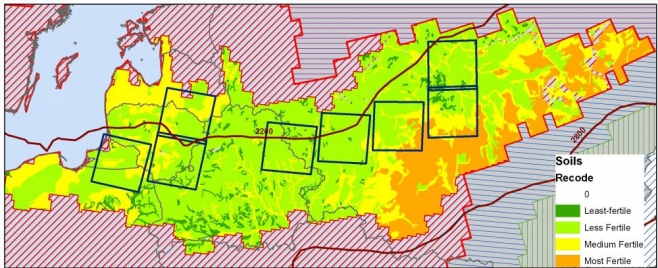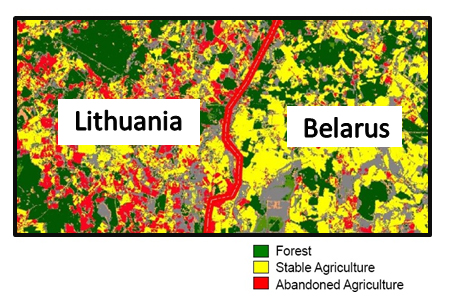Posted 08/9/10
Alexander Prishchepov is looking at region in Eastern Europe that allows constructing and testing hypothesis about land use changes in a transition from command to market economy. He is using remote sensing data from 1989 until 1999 and estimates abandonment rates in one agro-climatic region in temperate Eastern Europe, covering Belarus, Latvia, Lithuania, European Russia, Poland. Substantial differences in abandonment rates exist between countries and explained by the agricultural policy they have chosen to pursue.

Humans are the leading drivers of land use change and their activities are controlled by institutions. So changes in institutions can translate in land use changes, but links between institutional changes and land use are not well quantified and understood and lacking comprehensive case study. Alexander Prishchepov picked up Eastern Europe as the region that represents such a natural experiment, allowing constructing and testing hypothesis and study land use changes after the transition from command to market economy.Alexander defined the region homogenous in agroclimatic conditions, in temperate zone of Eastern Europe. This study region spans several post-socialist countries, including Belarus, Latvia, Lithuania, European Russia, Poland, which all share common starting point and experienced different trajectory. Using multi-date Landsat 30m remote sensing data for period from 1989 until 1999, he determined how much and where croplands were abandoned in these different countries. Monitoring of agricultural abandonment was not trivial because of the dynamic nature of the land cover, so Alexander spent lots of time testing important image dates in the field to collect data which further would be used for validating his results.

Results showed that 1.8 of 5.3 million hectares of agricultural lands in the study area were abandoned in the study region. Substantial differences in rates of abandoned agricultural lands existed between countries. Most of the lands were abandoned in those countries, where institutions were weak during the transition and privatization was incomplete (Latvia, Lithuania and Russia). Interestingly lowest percent of abandonment was in countries with very different trajectories of change, Belarus and Poland. In Belarus, abandonment was prevented by strict state regulations and support through subsidies, all agricultural lands remained in state property, while in Poland private property existed before the transition and percent of abandonment was low. Overall Alexander found that actual abandoned area was considerably larger than reported previously, which, given lack of official statistics on this topic highlighting good application for remote sensing approaches, that he used.

Additional analysis showed, that rate of abandonment were not very different in different administrative regions of Russia, highlighting strong top-down regulation common for all sub-regions of the country. It was also found, that area of active agriculture continued to decline when analysis for Russia was expanded until 2007. In order to achieve quantitative understanding of these changes, Alexander also performed statistical analysis of determining factors of agricultural abandonment in Russia that showed that abandonment was mostly explained by economic factors. Macroeconomic factors were more important on provincial (oblast) level, and local decision making on microlevel. For example abandoned lands had lower yields before breakdown of USSR, but still developed pre-transition been subsidized before. The withdrawal of the subsidies caused abandonment of socially and environmentally marginally agricultural lands with low crop yields.Abandoned lands might be used for conservation of biodiversity, but may also rationally returned to the agricultural production or used for producing biofuels. Though Alexander’s study covers one agro-climatic region of Eastern Europe, it gives an idea of what vast areas were abandoned in former Socialist block in total and what huge potential it provides.”
Story by Maxim Dubinin
